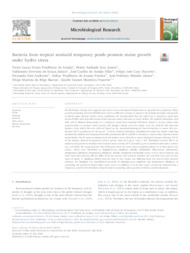Bacteria from tropical semiarid temporary ponds promote maize growth under hydric stress.
Bacteria from tropical semiarid temporary ponds promote maize growth under hydric stress.
Author(s): ARAÚJO, V. L. V. P. de; LIRA JUNIOR, M. A.; SOUZA JÚNIOR, V. S. de; ARAUJO FILHO, J. C. de; FRACETTO, F. J. C.; ANDREOTE, F. D.; PEREIRA, A. P. de A.; MENDES JÚNIOR, J. P.; BARROS, F. M. do R.; FRACETTO, G. G. M.
Summary: World climate change has triggered soil water stress and imposed limitations on agricultural production. Plant growth-promoting bacteria (PGPBs) have been an efficient strategy to improve the biological supply and growth of plants under distinct abiotic stress conditions. We hypothesized that the soils from a temporary pond may harbor PGPBs with potential strains which increase maize tolerance to water deficit. We studied rhizosphere and bulk soil of Mimosa bimucronata in a temporary pond from semiarid Northeast Brazil to access strains with characteristics to promote plant growth and mitigate abiotic stress for maize crop. We isolated 355 bacterial isolates, from which 96 were selected based on the morphophysiological characterization to assess IAA production (42 % produced over 50 ug mL-1 of IAA), calcium phosphate solubilization (with one isolate achieving medium IS), biofilm and exopolysaccharides production (66 % and 98 % of isolates, respectively). Based on these mechanisms, the 30 most promising bacterial isolates were selected to assess biological nitrogen fixation (74 % of the isolates showed nitrogenase activity greater than 20 C2H4.h-1.mg-1), ACC deaminase activity (80 % of isolates) and growth in medium with reduced water activity (8 % of isolates grew in medium with water activity (Aw) of 0.844). We sequenced the 16S rRNA gene from the seven most promising isolates in in vitro and in vivo assays, which were identified as Staphylococcus edaphicus, Bacillus wiedmannii, Micrococcus yunnanensis, Streptomyces alboflavus, Streptomyces alboflavus, Bacillus wiedmanni and Bacillus cereus. In vivo, eleven isolates and three bacterial consortia did not differ from the control with nutrient solution, for total leaf area and root dry mass of maize. S. alboflavus (BS43) had the best in vivo results, not differing from the control with nutrient solution. We highlight the unpublished potential of Staphylococcus edaphicus and Streptomyces alboflavus in promoting the growth of plants under water stress. In addition, it is the first report of bacteria isolated from a temporary pond in the Brazilian semiarid which promoting plant growth attributes and development.
Publication year: 2020
Types of publication: Journal article
Unit: Embrapa Soils
Keywords: Estresse hídrico, Mimosa Bimucronata, PGPBs, Semiarid zones, Semiárido, Water stress, Wetlands, Zea Mays, Zonas úmidas
Observation
Some of Embrapa's publications are published as ePub files. To read them, use or download one of the following free software options to your computer or mobile device. Android: Google Play Books; IOS: iBooks; Windows and Linux: Calibre.
Access other publications
Access the Agricultural Research Database (BDPA) to consult Embrapa's full library collection and records.
Visit Embrapa Bookstore to purchase books and other publications sold by Embrapa.

